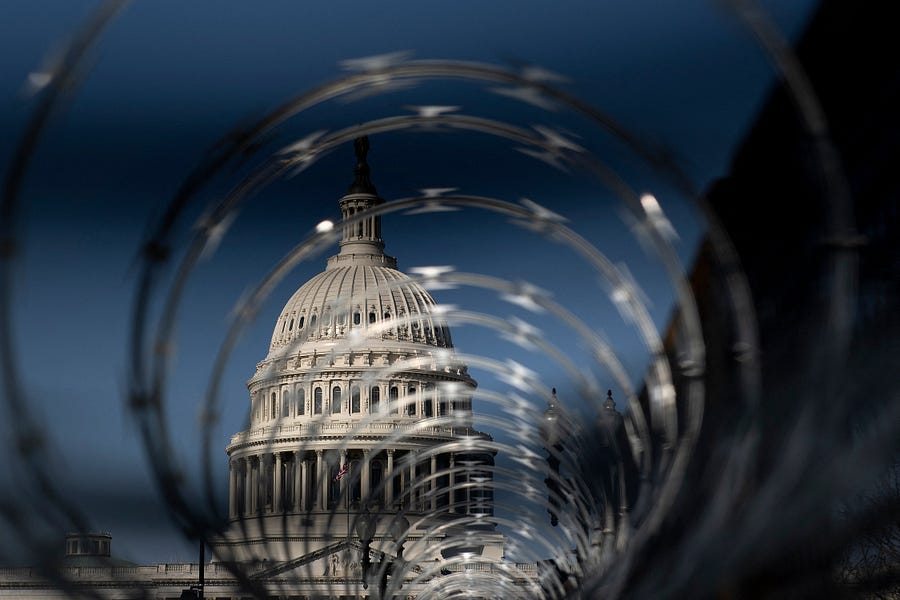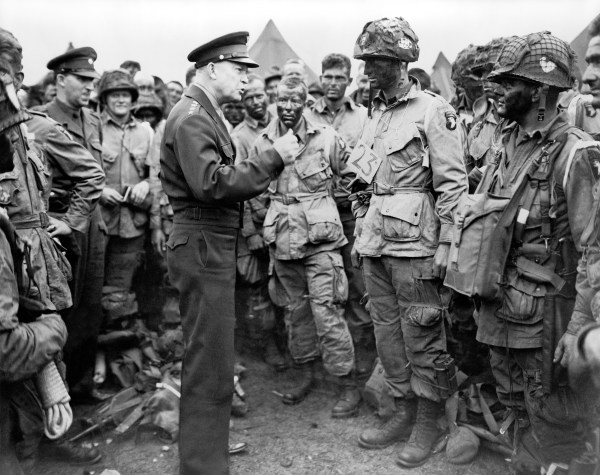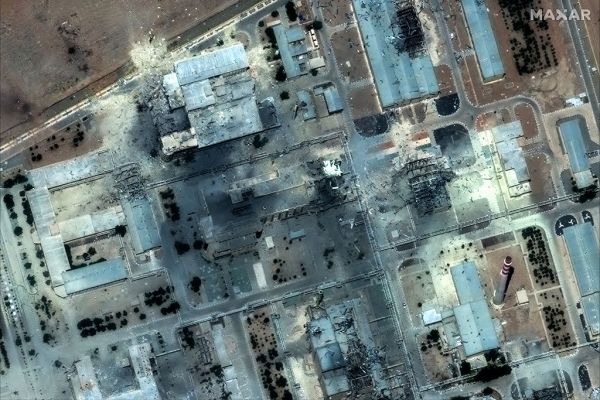Good morning. Let’s get right to it.
Lawmakers Push to Limit Capitol Security Measures
On a typical spring day at the U.S. Capitol, tourists from around the country and the world stroll past, taking photographs with the building and going on tours inside. D.C. residents jog around the complex, enjoying the scenery and the open spaces. Parents bring their children to play in the grass outside the building. Dogs go on walks with their owners. People sit under blooming trees and read books. Official visitors walk right up to the entrance to check in for their appointments, and Hill staff come and go to different coffee shops and restaurants nearby. Members of Congress on their way to votes pass by a few familiar protesters outside the building, making quips about their eccentric cardboard signs. Congressional leaders host press conferences on the House steps while tourists and other passers-by look on.
Much of the Capitol’s unique atmosphere disappeared at the beginning of the coronavirus pandemic. Hill leaders closed the building to public tours early on. Many congressional staffers began working from home. Fewer reporters worked from the building, setting up a pool system to share information and limit the number of journalists who were there at a given time. Members of Congress, wearing masks and avoiding unnecessary contact with others, had fewer casual interactions. Coffee meetings that used to turn office building cafeterias into a disorienting cacophony of business became Zoom calls.
What the pandemic didn’t take away, the January 6 attack on the Capitol did. More than two months after the building was mobbed, it is a fortress surrounded by National Guard troops and fencing. Tourists aren’t able to take photos of the famous dome without catching razor wire or fencing in their shot. D.C. residents aren’t able to jog or walk their dogs on the grounds. Local kids weren’t able to go sledding on the hill facing the National Mall when D.C. got snow in February.
Members of Congress are tired of it. Conditions on the ground right now are vastly different than they were leading up to January 6. Former President Donald Trump is not actively pushing for thousands of his supporters to come to Washington, D.C., and the odds of a comparably massive mob mobilizing on short notice are slim. There are remaining concerns about smaller groups of extremists who still view the Capitol and members as targets, but lawmakers from both parties argue that can be addressed through other, less extreme precautions instead of locking down the whole area.
Last week, members in both chambers released letters and statements pushing back on the fencing around the building and calling for the complex to be opened up.
Reps. Adam Smith and Mike Rogers, respectively the top Democrat and Republican on the House Armed Services Committee, issued a joint statement urging a drawdown of the National Guard presence in DC.
“We are deeply troubled by the current level of security around the United States Capitol. More than two months after the January 6 attack, the seat of our nation’s democracy remains heavily protected by guardsmen and surrounded by a perimeter fence,” they said.
They added that there “is no doubt” that some level of National Guard support should remain in the region, but “the present security posture is not warranted at this time.”
The next day, several Republican senators sent a letter to acting U.S. Capitol Police Chief Yogananda Pittman questioning why the fence is still in place.
“It is entirely unclear to us why the fencing around the complex remains, given the absence of any current specific threat to the Capitol and given the ability to rapidly re-deploy fencing should that threat posture change,” they wrote.
They also expressed opposition to the idea of a more permanent barrier around the complex: “This fence sends a terrible message to American citizens, as well as to our allies and adversaries, and it is not a long-term security solution,” they said.
Senate Minority Leader Mitch McConnell chimed in, saying at a press conference that he is “extremely uncomfortable with the fact that my constituents can’t come to the Capitol with all this razor wire around the complex. It reminds me of my last visit to Kabul.”
Security officials seem to have gotten the memo, although their staggered approach likely won’t satisfy the members who have raised concerns.
Acting House Sergeant at Arms Timothy Blodgett said in a note to lawmakers and staff on Monday that the U.S. Capitol Police, in coordination with government intelligence partners, has determined that “there does not exist a known, credible threat against Congress or the Capitol Complex that warrants the temporary security fencing.”
One might assume that determination means the fencing, which was erected swiftly after the mobbing of the Capitol, could now be removed just as quickly. But security officials are rolling back the security measures in phases, without committing to a firm timeline for complete removal.
The outer fencing surrounding the Capitol complex will be taken down, and an inner fence perimeter will be moved closer to the building, Blodgett said Monday. The razor wire currently atop the inner fencing will be removed. In place of the outer fencing, bike racks—shorter barriers used for crowd control—will be placed around the House office buildings. He didn’t provide a timeline for when the inner perimeter will be taken down, saying it will stay in place while the Architect of the Capitol continues to make repairs to the building.
Blodgett added that the National Guard will continue to “maintain a presence and an increased security posture,” but it is anticipated that the posture will be reduced “in the coming weeks.”
The changes he outlined will help with traffic flow in the area, and it will open up some sidewalks that had been crowded out by the fencing. But it still won’t represent an opening up of the complex in earnest.
In a recent task force report about how to enhance the Capitol’s security, retired Army Lt. Gen Russel Honoré said lawmakers should pursue expanding the U.S. Capitol Police itself, including more personnel and training for its intelligence unit.
He also acknowledged the “competing desires for maximum public access and guaranteed security” that make decisions about security measures difficult. He suggested replacing the temporary fencing with “a mobile fencing option that is easily erected and deconstructed,” and, in the long term, a retractable fencing system.
“Such a solution could enable an open campus while giving security forces better options to protect the complex and its Members should a threat develop,” Honoré said in the report.
But any kind of permanent fence—even a retractable one—is sure to face opposition from members of both parties.
D.C. Delegate Eleanor Holmes Norton introduced a very straightforward bill last month to block federal funds from being used to install permanent fencing around the Capitol complex. In a testament to the ideological diversity surrounding the issue, four Republicans have signed onto it, along with four Democrats—including progressive Reps. Ayanna Pressley and Ilhan Omar.
But there’s also a partisan element making the debate more toxic. Some Republicans, like freshman Rep. Lauren Boebert, have slammed Democrats for the fencing, labeling it “Fort Pelosi.”
Even as many rank-and-file Democrats agree that the barrier is not necessary any longer, they have bristled at Republicans’ attacks over the security measures, arguing people like Boebert, who supported efforts to overturn the election, have no room to complain. In response to Boebert’s Twitter video about the fencing, Democratic Congressional Campaign Committee Chairman Rep. Sean Patrick Maloney wrote that Republicans are “great at inciting QAnon violence with snappy videos about problems they created.”
And Rep. Pramila Jayapal brushed off McConnell’s concerns about the perimeter, making the case that he should have voted to impeach former President Donald Trump to send a message to his supporters who attacked the building.
“I don’t like the razor wire either,” Jayapal said on CNN over the weekend. “But I also like being alive.”
On the Floor
The Senate approved Rep. Debra Haaland’s nomination to be secretary of the interior last night with a vote of 51-40, with four Republicans voting alongside Democrats in her favor. The chamber is also expected to vote on Katherine Tai’s nomination to be U.S. trade representative and Isabella Guzman’s nomination to lead the Small Business Administration this week.
The House will vote on legislation to reauthorize the Violence Against Women Act, which funds programs to help survivors of domestic violence and sexual assault. The House will also vote on a resolution to remove the 1982 deadline for the ratification of the Equal Rights Amendment. Members will also take up legislation to protect unauthorized immigrants who were brought to the United States as children, as well as another bill to create a pathway for agricultural workers who are in the country illegally to earn legal status. The first immigration bill won only a handful of Republican votes when it was brought to the floor during the last Congress, but the agricultural workers legislation had support from more than 30 Republicans. Neither received a vote in the Senate when it was held by Republicans.
Key Hearings
-
The Senate Foreign Relations Committee will hold a hearing Wednesday at 10 a.m. to examine effective policies for strategic competition with the Chinese government. Senators will likely discuss their priorities for a broad China package. (You can read more about that in last Friday’s Uphill.)
-
Dr. Anthony Fauci, director of the National Institute for Allergy and Infectious Diseases, will appear alongside CDC Director Rochelle Walensky and Dr. Peter Marks, the director of the Center for Biologics Evaluation and Research, to discuss vaccine distribution during a House Energy and Commerce subcommittee hearing Wednesday at 10 a.m.
-
Fauci, Walensky, and Marks will testify again at 10 a.m. Thursday before the Senate Health, Education, Labor, and Pensions Committee.
-
Secretary of Homeland Security Alejandro Mayorkas will appear before the House Homeland Security Committee to talk about the future of the department on Wednesday at 9:30 a.m.
-
Belarus opposition leader Sviatlana Tsikhanouskaya will testify before a House Foreign Affairs subcommittee on Wednesday morning about the democratic movement in Belarus.
-
The House Financial Services Committee will hold a hearing on Gamestop and short selling Wednesday at 10 a.m.
-
Two former secretaries of DHS—Jeh Johnson and Michael Chertoff—will testify before a House Appropriations subcommittee Wednesday at 10 a.m. on the department’s management challenges.
-
The House Science, Space, and Technology Committee will hear from experts on the Texas blackouts and the research needs for a more resilient power grid on Thursday morning.
-
A House Judiciary subcommittee will hold a hearing Thursday morning on discrimination and violence against Asian-Americans.
-
Michael Carvajal, director of the Federal Bureau of Prisons, is set to appear before a House Appropriations subcommittee on Thursday afternoon to answer questions about coronavirus outbreaks and management problems during the pandemic.
-
The Senate Homeland Security and Governmental Affairs Committee will hold a hearing Thursday morning on understanding and responding to the SolarWinds supply chain attack.






Please note that we at The Dispatch hold ourselves, our work, and our commenters to a higher standard than other places on the internet. We welcome comments that foster genuine debate or discussion—including comments critical of us or our work—but responses that include ad hominem attacks on fellow Dispatch members or are intended to stoke fear and anger may be moderated.
With your membership, you only have the ability to comment on The Morning Dispatch articles. Consider upgrading to join the conversation everywhere.